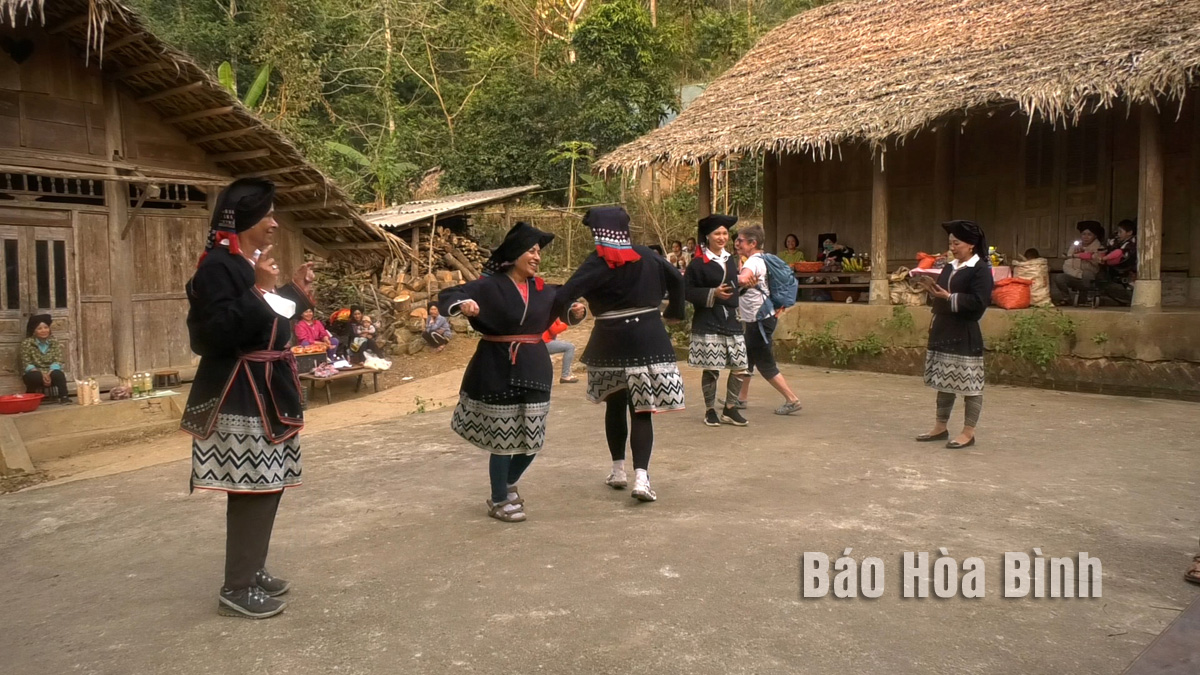
With a rich history of traditional culture, ethnic groups in Da Bac district, Hoa Binh province still retain their own cultural identity values such as dialect languages, traditional festivals, costumes, among others. These are favourable conditions for the locals to preserve, conserve and promote traditional cultural values while building attractive and diverse tourism products to attract tourists and bolster local socio-economic development.
Tourists in costumes of Dao ethnic people in Cao Son
commune, Da Bac district.
Sung hamlet, Cao Son commune is one of hamlets that keeps almost intact the
lifestyle, customs, and cultural identity of local Dao Tien ethnic group in Da
Bac. Dialect language, food and handicraft trades have been preserved and
maintained in their daily life.
Since tourism has been promoted in the locality, local Dao ethnic people have
selected some handicraft trades to develop them into tourism products such as
brocade weaving.
Residents in Sung hamlet have invested in building a spacious hamlet while
maintaining a clean landscape and environment over the years. Homestays are
well-invested, and more services have been introduced to meet the sightseeing
and relaxation demand of tourists.
In recent times, the hamlet has restored the craft of making Do paper, helping
tourists to learn and understand about the trade while contributing to
increasing incomes for local ethnic residents.
In addition, folk dances, such as bell, sword and lantern dances, and some
unique rites in ritual ceremonies or the use of khen (panpipe) music
instrument, among others have been added in art programmes to serve tourists.
Ban Kim Quy, Vice Chairman of the Da Bac District People's Committee, said
thanks to the promotion of traditional folk materials, art performances have
received warm response from tourists. Community-based tourism has been formed
and developed, attracting many tourists every year, contributing to poverty
reduction, and improving the locals' life.
In community-based tourism sites in the district, in addtion to promoting
traditional materials to develop tourism products, more attention has been paid
to the practice ofcultural heritage in the community toward sustainable
tourism development.
National cultural identity has become resources for community-based tourism
development. On the contrary, the more tourism develops, the more people are
encouraged to preserve their traditional cultural heritage, she added.
A diverse chain of eco-tourism and resort destinations concentrated in Hoa Binh city and the districts of Tan Lac, Da Bac, and Luong Son… Along with the launch of several key high-quality resort tourism projects, these developments have reshaped the landscape and enhanced the appeal of Hoa Binh as a travel destination.
Boasting diverse terrain, a mild climate, and rich natural resources, Cao Phong district is increasingly asserting its place on Vietnam’s tourism map, attracting both domestic and foreign visitors. The district is renowned for its stunning landscapes, majestic mountains, a crystal-clear hydropower lake, and the unique cultural identity of local ethnic groups.
With its pristine landscapes, unique cultural heritage of Muong ethnic minority, and an expanding range of visitor experiences, Tan Lac district of Hoa Binh has fast become a captivating destination for both domestic and international tourists.
Until now, Sung village in Cao Son commune, Da Bac district remains the only Dao ethnic community in Hoa Binh province to develop a community-based tourism model. Beyond its untouched natural landscapes, cultural identity serves as the cornerstone attraction for visitors.
Alongside the diverse cultural identities of the Kinh, Muong, Tay, Thai, Dao, and Mong ethnic people, Hoa Binh province is also renowned as the "capital" of the northwestern Vietnamese cuisine, offering unique and distinctive dishes. At festivals, during Lunar New Year (Tet), or on significant family or community occasions, special dishes are prepared, leaving a lasting impression on visitors.
A Phong Linh (Yellow Tabebuia) flower garden in Thang village, Thach Yen commune, Cao Phong district is currently in full bloom, drawing a large number of visitors.



